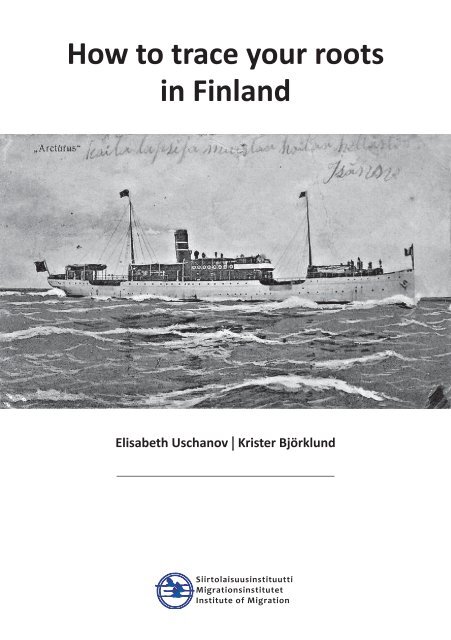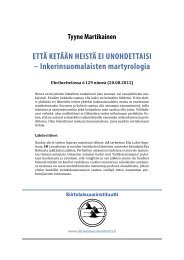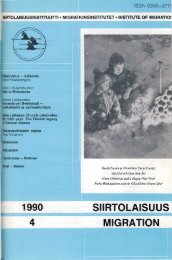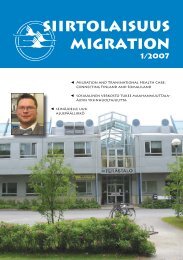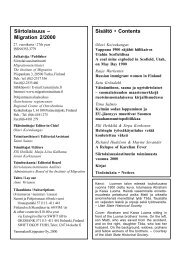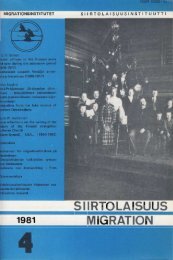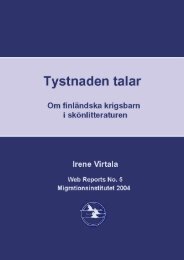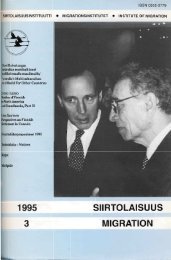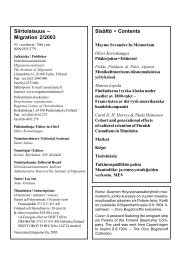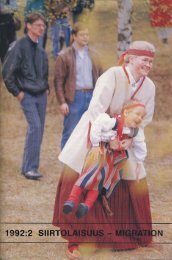How to trace your roots in Finland - Siirtolaisuusinstituutti
How to trace your roots in Finland - Siirtolaisuusinstituutti
How to trace your roots in Finland - Siirtolaisuusinstituutti
You also want an ePaper? Increase the reach of your titles
YUMPU automatically turns print PDFs into web optimized ePapers that Google loves.
<strong>How</strong> <strong>to</strong> <strong>trace</strong> <strong>your</strong> <strong>roots</strong><br />
<strong>in</strong> F<strong>in</strong>land<br />
Elisabeth Uschanov | Krister Björklund<br />
Siir<strong>to</strong>laisuus<strong>in</strong>stituutti<br />
Migrations<strong>in</strong>stitutet<br />
Institute of Migration
The Institute of Migration<br />
The Institute of Migration was founded <strong>in</strong> 1974, and has its headquarters <strong>in</strong> Turku. The Institute<br />
is ma<strong>in</strong>ta<strong>in</strong>ed by a non-profit-mak<strong>in</strong>g trust and is basically f<strong>in</strong>anced by an annual operat<strong>in</strong>g<br />
grant from the F<strong>in</strong>nish M<strong>in</strong>istry of Education.<br />
The Institute carries out and promotes research <strong>in</strong> the field of migration, his<strong>to</strong>rical as<br />
well as contemporary and also collects and s<strong>to</strong>res different k<strong>in</strong>ds of material relat<strong>in</strong>g <strong>to</strong> migration<br />
and ethnic questions. The Institute ma<strong>in</strong>ta<strong>in</strong>s a register of researchers work<strong>in</strong>g <strong>in</strong><br />
these fields, arranges sem<strong>in</strong>ars and conferences <strong>to</strong> promote scholarly collaboration. The Institute<br />
is responsible for six series of scholarly publications and publishes its own quarterly<br />
periodical Siir<strong>to</strong>laisuus-Migration.<br />
The Archives of the Institute conta<strong>in</strong> approx. 220 meters of documents, ca. 14 000 pho<strong>to</strong>graphs,<br />
letters, post cards, <strong>in</strong>terviews, musical record<strong>in</strong>gs, museum pieces etc.<br />
The Institute Library specializes <strong>in</strong> scholarly and other publications relat<strong>in</strong>g <strong>to</strong> <strong>in</strong>ternational<br />
and domestic migration. The Library subscribes <strong>to</strong> most of F<strong>in</strong>nish newspapers and<br />
magaz<strong>in</strong>es published <strong>in</strong> other countries around the world and <strong>to</strong> many specialist periodicals<br />
deal<strong>in</strong>g with migration. The library counts more than 7 000 titles, and <strong>in</strong>formation service<br />
is available for the public. One important way <strong>in</strong> which the Institute promotes a greater<br />
awareness of migration is through arrang<strong>in</strong>g exhibitions.<br />
The Emigrant Register was established <strong>in</strong> 1989 as a service for genealogists and the descendants<br />
of F<strong>in</strong>nish emigrants. The foundation of a computerized register was a part of<br />
the Delaware 350 Anniversary, <strong>to</strong> commemorate the beg<strong>in</strong>n<strong>in</strong>g of F<strong>in</strong>nish Emigration <strong>to</strong><br />
North America. The data is mostly related <strong>to</strong> the migration event, the databases of the<br />
ma<strong>in</strong> sources of <strong>in</strong>formation, official passport registers and passenger lists of the F<strong>in</strong>land<br />
Steamship Company are available on the Internet.<br />
The web site of the Institute at http://www.migration<strong>in</strong>stitute.fi / provides articles, reports,<br />
the <strong>in</strong>stitute’s periodical, statistics, picture galleries, exhibitions, a web shop where you can buy<br />
books, useful l<strong>in</strong>ks and other <strong>in</strong>formation concern<strong>in</strong>g F<strong>in</strong>nish migration.<br />
Institute of Migration<br />
Eerik<strong>in</strong>katu 34, 20100 Turku, F<strong>in</strong>land<br />
Tel. +358 2 2840 440<br />
www.migration<strong>in</strong>stitute.fi<br />
2
Contents<br />
The Institute of Migration 2<br />
Introduction 4<br />
Overview of F<strong>in</strong>nish Migration <strong>to</strong> America 5<br />
Start Your Search <strong>in</strong> North American Records 5<br />
Family Papers 5<br />
Official Records <strong>in</strong> North America 6<br />
Vital Records 7<br />
Census 7<br />
The SSDI 8<br />
Church Records 8<br />
Other Documents 8<br />
Documents Related <strong>to</strong> the Journey 8<br />
Lists of Arrivals 10<br />
St. Albans Border Cross<strong>in</strong>gs 11<br />
Lists of Departures 11<br />
The Passenger Lists of the F<strong>in</strong>land Steamship Company (F.Å.A) 11<br />
The Passport Lists 12<br />
F<strong>in</strong>nish Names 13<br />
Emigrants Chang<strong>in</strong>g their Names 14<br />
Records <strong>in</strong> F<strong>in</strong>land 15<br />
Church Records 15<br />
The Genealogy Method and available Church Records 16<br />
Other Archival Sources 18<br />
Literature 20<br />
Research Guide Books 20<br />
F<strong>in</strong>nish His<strong>to</strong>ry and Migration 20<br />
Addresses 22<br />
3
Introduction<br />
The popularity of trac<strong>in</strong>g one’s <strong>roots</strong> seems <strong>to</strong> be constantly <strong>in</strong>creas<strong>in</strong>g. Many genealogists<br />
feel at some po<strong>in</strong>t <strong>in</strong> their research that they have reached a po<strong>in</strong>t where no more<br />
<strong>in</strong>formation can be dug <strong>in</strong><strong>to</strong> daylight and those who are trac<strong>in</strong>g their overseas <strong>roots</strong> are<br />
more likely than other <strong>to</strong> run <strong>in</strong><strong>to</strong> what seems <strong>to</strong> be a brick wall. To carry on the search for<br />
their relatives, the <strong>in</strong>formation needed is <strong>to</strong> identify the place where the ances<strong>to</strong>rs lived.<br />
Those who have Nordic ancestry are better off than others, as the parishes have kept good<br />
records, which reach hundreds of years back, but the genealogist still needs <strong>to</strong> know where<br />
<strong>to</strong> search. Many start with great enthusiasm and high hopes, but the abundance of <strong>in</strong>formation<br />
on the <strong>in</strong>ternet easily leads astray and guidance is needed through the jungle of <strong>in</strong>formation.<br />
For those who plan <strong>to</strong> visit F<strong>in</strong>land <strong>to</strong> f<strong>in</strong>d their <strong>roots</strong>, good preparation is crucial,<br />
as much of the <strong>in</strong>formation can be gathered <strong>in</strong> advance and the better they prepare,<br />
the more they can f<strong>in</strong>d dur<strong>in</strong>g their trip.<br />
The purpose of this booklet is <strong>to</strong> help F<strong>in</strong>nish descendants <strong>to</strong> <strong>trace</strong> their <strong>roots</strong>. In the<br />
follow<strong>in</strong>g pages the most important <strong>in</strong>formation sources <strong>in</strong> F<strong>in</strong>land are described and what<br />
the genealogist can expect <strong>to</strong> f<strong>in</strong>d. Many of the sources can be utilized at home, through the<br />
Internet, by mail or telephone, but some of the basic <strong>in</strong>formation can only be researched<br />
on the spot. The reader should not expect a complete guide <strong>to</strong> genealogical sources <strong>in</strong> F<strong>in</strong>land,<br />
but these pages give an outl<strong>in</strong>e where <strong>to</strong> f<strong>in</strong>d the most important sources.<br />
4
Overview of F<strong>in</strong>nish Migration <strong>to</strong> America<br />
The great migration of F<strong>in</strong>ns <strong>to</strong> North America occurred dur<strong>in</strong>g the late n<strong>in</strong>eteenth and early<br />
twentieth century. Between the years 1864 and 1914 well over 300,000 F<strong>in</strong>ns settled <strong>in</strong> the<br />
USA and Canada. The “America Fever” started <strong>in</strong> the 1870s and became a mass movement<br />
<strong>in</strong> the follow<strong>in</strong>g decade. The crest of the wave was reached the year 1902 when over 20.000<br />
F<strong>in</strong>ns emigrated. Emigration cont<strong>in</strong>ued on a large scale until the outbreak of World War I.<br />
When the U.S. Government began <strong>to</strong> restrict the admission of immigrants <strong>in</strong> the 1920s, F<strong>in</strong>nish<br />
emigration shifted <strong>to</strong> Canada. The F<strong>in</strong>nish emigration <strong>to</strong> the U.S. was higher than the official<br />
statistics of these years reveal, because many immigrants who officially were not admitted<br />
<strong>to</strong> the U.S. went first <strong>to</strong> Canada and then crossed the border between the countries.<br />
The F<strong>in</strong>nish emigrants <strong>to</strong> America orig<strong>in</strong>ated ma<strong>in</strong>ly from north western F<strong>in</strong>land. Nearly<br />
half of them came from the prov<strong>in</strong>ce of Vaasa. They were young people, around 20 years of<br />
age; the majority was men and unmarried. The structural change <strong>in</strong> agriculture had created<br />
a population surplus, and jobs outside agriculture were scarce <strong>in</strong> F<strong>in</strong>land. In North America<br />
work was available for men <strong>in</strong> m<strong>in</strong>es, lumber camps, fac<strong>to</strong>ries and railroad construction.<br />
Women ga<strong>in</strong>ed employment as maids <strong>in</strong> the homes of wealthy Americans. The F<strong>in</strong>nish settlements<br />
concentrated <strong>in</strong> M<strong>in</strong>nesota, Michigan and Massachusetts. Also <strong>in</strong> Oregon and New<br />
York the F<strong>in</strong>ns were numerous.<br />
In Canada about 60 per cent of the F<strong>in</strong>nish population lived <strong>in</strong> Ontario, especially <strong>in</strong> Toron<strong>to</strong>,<br />
Sudbury and present Thunder Bay. Many F<strong>in</strong>ns also settled on the West Coast, but<br />
relatively few <strong>in</strong> prairie terri<strong>to</strong>ries or the French-speak<strong>in</strong>g areas. Although the F<strong>in</strong>ns formed<br />
less than one percent of the European immigration <strong>to</strong> North America their concentration,<br />
e.g. <strong>in</strong> Michigan and <strong>in</strong> Thunder Bay <strong>in</strong> Canada had a considerable impact on the local population.<br />
In m<strong>in</strong><strong>in</strong>g <strong>in</strong> upper Michigan the F<strong>in</strong>ns were quite visible, especially <strong>in</strong> the <strong>in</strong>dustrial<br />
strikes. A study made at Northern Michigan University drew the conclusion that the American<br />
F<strong>in</strong>ns had <strong>in</strong>fluenced the English spoken <strong>in</strong> northern Michigan.<br />
S<strong>in</strong>ce the Second World war F<strong>in</strong>nish migration <strong>to</strong> North America has been quite <strong>in</strong>significant;<br />
around 15 000 emigrants went <strong>to</strong> the United States and 27 000 <strong>to</strong> Canada. In North<br />
America there are about 45 000 first generation and 180 000 second generation F<strong>in</strong>ns. Includ<strong>in</strong>g<br />
later generations there are over a million people of F<strong>in</strong>nish extraction – a substantial<br />
contribution <strong>to</strong> the ethnic and cultural mosaic of the United States and Canada.<br />
Start Your Search <strong>in</strong> North American Records<br />
Family Papers<br />
Trac<strong>in</strong>g <strong>your</strong> <strong>roots</strong> and genealogical research often means compil<strong>in</strong>g bits and pieces of <strong>in</strong>formation<br />
<strong>to</strong>gether. Sometimes a paper of seem<strong>in</strong>gly little <strong>in</strong>terest or a remark by a relative<br />
can be an important push forward. Archives, offices and libraries often provide lots of ma-<br />
5
terial for construct<strong>in</strong>g the family tree, but before gather<strong>in</strong>g and study<strong>in</strong>g official documents<br />
for fill<strong>in</strong>g the blanks <strong>in</strong> <strong>your</strong> family his<strong>to</strong>ry, you should start at home with the material <strong>in</strong> the<br />
possession of <strong>your</strong> family and relatives, oral <strong>in</strong>formation as well as written.<br />
The most important task is <strong>to</strong> determ<strong>in</strong>e the place <strong>in</strong> F<strong>in</strong>land where the family orig<strong>in</strong>ally<br />
came from and what was the orig<strong>in</strong>al F<strong>in</strong>nish name of the ances<strong>to</strong>rs, which may have<br />
changed after arriv<strong>in</strong>g <strong>in</strong> America, <strong>in</strong>tentionally or through marriage. If the ties and contacts<br />
<strong>to</strong> the old home country and the relatives there still rema<strong>in</strong>, cross<strong>in</strong>g the Atlantic is<br />
easy, but if there are no family ties left, f<strong>in</strong>d<strong>in</strong>g the family on the other side of the Atlantic<br />
might require lots of work and effort.<br />
Parents, grandparents, great-grandparents and other elderly relatives remember details<br />
about persons and what happened <strong>in</strong> the past. Interview<strong>in</strong>g a relative can give lots of <strong>in</strong>formation,<br />
which cannot be found <strong>in</strong> any document. Notes about births, marriages and deaths<br />
<strong>in</strong> the old family bible provide valuable <strong>in</strong>formation when start<strong>in</strong>g genealogical research.<br />
This <strong>in</strong>formation might, however, be <strong>in</strong>complete and <strong>in</strong>correct. Almost every family keeps<br />
birth-, marriage- and death certificates <strong>in</strong> their home archives, which are of great <strong>in</strong>terest.<br />
Also old school-, military- and retirement records as well as membership records of associations<br />
and organizations give <strong>in</strong>formation on life of old. Often documents like deeds of estate<br />
distribution, land acquisition and the like can be found at home. It is also a common habit<br />
<strong>to</strong> collect obituaries and anniversary notices from newspapers about family members.<br />
All F<strong>in</strong>nish emigrants did not apply for American citizenship, but Certificates of Intention<br />
of becom<strong>in</strong>g US citizens and Certificates of Naturalization are important documents when<br />
research<strong>in</strong>g <strong>your</strong> family his<strong>to</strong>ry. They do not necessarily list the place of orig<strong>in</strong> <strong>in</strong> F<strong>in</strong>land,<br />
but always the arrival <strong>in</strong> America and often the name of the ship and port of arrival.<br />
The family member who once arrived <strong>in</strong> America might have brought along pho<strong>to</strong>graphs<br />
and documents from the old country, which some relative could have <strong>in</strong> his possession. The<br />
most valuable document is the emigrant’s passport, because it shows the orig<strong>in</strong>al name <strong>in</strong><br />
F<strong>in</strong>land, date of birth, home parish, profession and the date of emigration. Sometimes the<br />
emigrant also had an extract from the parish register (virka<strong>to</strong>distus, pap<strong>in</strong>kirja, muut<strong>to</strong><strong>to</strong>distus)<br />
issued for the purpose of emigration.<br />
Old pho<strong>to</strong>graphs are <strong>in</strong>terest<strong>in</strong>g, but unfortunately the names of the persons appear<strong>in</strong>g<br />
are seldom written down. Notes and diaries written by the emigrant are very valuable<br />
as well as letters and postcards sent from F<strong>in</strong>land. These may conta<strong>in</strong> addresses, names<br />
of persons and places, <strong>in</strong>formation on relatives and more. These documents are usually <strong>in</strong><br />
F<strong>in</strong>nish or Swedish, which means that the genealogist needs assistance if he does not know<br />
the languages.<br />
Official Records <strong>in</strong> North America<br />
This section assists <strong>in</strong> do<strong>in</strong>g genealogical research us<strong>in</strong>g official records <strong>in</strong> North America. It<br />
is most important <strong>to</strong> exhaust these before ventur<strong>in</strong>g <strong>in</strong><strong>to</strong> archival searches <strong>in</strong> F<strong>in</strong>land. Surpris<strong>in</strong>gly<br />
much <strong>in</strong>formation as basis can be found quite close.<br />
6
Vital Records<br />
In trac<strong>in</strong>g the his<strong>to</strong>ry of immigrants and their descendants, the public records of their new<br />
country are important sources of <strong>in</strong>formation. In North America, there is no national poll<br />
register; population records are the responsibility of State, County or City officials. Each<br />
state has the equivalent of a bureau of vital records. It’s generally called the “Bureau of Vital<br />
Statistics,” “Division of Records and Statistics,” “Division of Public Health,” “Vital Records<br />
Division,” or some similar title.<br />
Vital records document important events of an <strong>in</strong>dividual’s life: birth, marriage, death<br />
and divorce. In general, vital records weren’t kept <strong>in</strong> the United States until the early 1900s,<br />
only some local records <strong>in</strong> state archives and libraries go further back. The <strong>in</strong>formation <strong>in</strong><br />
the documents varies. Usually they conta<strong>in</strong> the full name of the <strong>in</strong>dividual <strong>in</strong>volved <strong>in</strong> the<br />
event, the date of the event, and the county, state, or <strong>to</strong>wn where the event <strong>to</strong>ok place.<br />
Many vital records conta<strong>in</strong> much more <strong>in</strong>formation than this.<br />
To request a copy of a vital record you normally need <strong>to</strong> contact the appropriate state<br />
agency. States require a fee for each certificate. In most cases, you pay first and then wait<br />
for the state agency <strong>to</strong> mail the record <strong>to</strong> you. Response time varies widely and can range<br />
from a week <strong>to</strong> several months. A comprehensive guide <strong>to</strong> vital records can be found at<br />
http://www.vitalrec.com.<br />
Much of this also applies for Canada, but as modern Canada is the merger of French and<br />
English colonies, each with its own language and record keep<strong>in</strong>g methods, problems may<br />
arise. The privacy laws are also stricter than <strong>in</strong> the US. Generally, the Canadian prov<strong>in</strong>ces<br />
where most F<strong>in</strong>ns went have local adm<strong>in</strong>istrations not differ<strong>in</strong>g much from their American<br />
counterparts. Be<strong>in</strong>g part of the British Commonwealth, some Canadian records are kept <strong>in</strong><br />
Great Brita<strong>in</strong>, e.g. military archives from the First and Second World War.<br />
Census<br />
Censuses are good sources for genealogical <strong>in</strong>formation, s<strong>in</strong>ce they also give <strong>in</strong>formation<br />
on household and family level. The United States Congress requisitioned the first official<br />
census <strong>in</strong> 1790 <strong>to</strong> ensure that each state was assigned a fair number of congressional representatives.<br />
One census is completed every ten years. The first time that F<strong>in</strong>ns were listed<br />
separately <strong>in</strong> the US Census was <strong>in</strong> 1900. Earlier they were classified as Russian. The most<br />
recent records open <strong>to</strong> genealogists are those for the 1930 census.<br />
Information is given on e.g. name, marital status, number of children born (<strong>to</strong> the wife,<br />
widow or divorcee), year of immigration, whether naturalized or alien, whether able <strong>to</strong><br />
speak English, occupation and much more data, depend<strong>in</strong>g on the year of the census.<br />
As <strong>in</strong> the United States, censuses were conducted <strong>in</strong> Canada every ten years. Returns<br />
from all of the censuses up <strong>to</strong> and <strong>in</strong>clud<strong>in</strong>g 1901 are freely available. The paper returns for<br />
censuses after 1901 (up <strong>to</strong> 1991) were destroyed after the records were put on<strong>to</strong> microfilm.<br />
These microfilms, under the control of Statistics Canada, are s<strong>to</strong>red at the National Capital Region<br />
Federal Records Centre of the National Archives.<br />
Ancestry.com (http://ancestry.com) hosts onl<strong>in</strong>e census records from 1790–1930 for<br />
both US and Canada.<br />
7
The SSDI<br />
The Social Security Death Index (SSDI) is a good resource for f<strong>in</strong>d<strong>in</strong>g <strong>in</strong>formation on Americans<br />
who died after the 1960s. Most of the <strong>in</strong>formation <strong>in</strong>cluded <strong>in</strong> this <strong>in</strong>dex is from 1960’s<br />
<strong>to</strong> the present, although some data is from as early as 1937. A record will conta<strong>in</strong> some or<br />
all of the follow<strong>in</strong>g <strong>in</strong>formation: last name, first name, birth date, death date, Social Security<br />
number, the state of residence where the Social Security number (SSN) was issued, the<br />
last known residence and the location where the last benefit payment was sent. For <strong>in</strong>dividuals<br />
who died while resid<strong>in</strong>g outside of the U.S., the record may also <strong>in</strong>clude a special<br />
state or country residence code. SSDI is available at www.ancestry.com<br />
Church Records<br />
In addition <strong>to</strong> the public records, most churches also kept records of their members. In the<br />
Lutheran congregations set up by the F<strong>in</strong>nish immigrants, F<strong>in</strong>nish archive practices were<br />
observed: births, marriages and deaths were listed annually <strong>in</strong> chronological order. This<br />
<strong>in</strong>formation was then also recorded <strong>in</strong> the Congregation Records by family. Some 20 per<br />
cent of the F<strong>in</strong>nish emigrants were members. There were hundreds of F<strong>in</strong>nish and Swedish<br />
F<strong>in</strong>nish parishes <strong>in</strong> both the United States and Canada, but no complete list of these exists.<br />
The Genealogical Society of F<strong>in</strong>land gathers <strong>in</strong>formation of F<strong>in</strong>nish-American churches at<br />
http://www.genealogia.fi /church/<strong>in</strong>dex.htm<br />
Orig<strong>in</strong>al records and microfilms of F<strong>in</strong>nish-American church records are kept at the F<strong>in</strong>nish-American<br />
Heritage Center at F<strong>in</strong>landia University (former Suomi College) <strong>in</strong> Hancock,<br />
Michigan. The Center also has archival material on temperance and other societies, newspapers,<br />
periodicals, personal papers and more (http://www.f<strong>in</strong>landia.edu/heritage-center<strong>in</strong>-f<strong>in</strong>nish.html).<br />
Other Documents<br />
The officials deal<strong>in</strong>g with immigrants produced a large amount of documentation. Researchers<br />
often overlook the importance of these as a source of family his<strong>to</strong>ry <strong>in</strong>formation.<br />
Such are Naturalization records, land records (<strong>in</strong>clud<strong>in</strong>g “Plat Books”-map collections), probate<br />
records, taxation, military service, court records and <strong>in</strong>heritance records. They can be<br />
found from local officials and from the National Archives <strong>in</strong> USA and Canada. For genealogists<br />
the most important documents relat<strong>in</strong>g <strong>to</strong> the naturalization are the duplicate copies made<br />
after 1906, which are s<strong>to</strong>red at the Immigration and Naturalization Service. Many of above<br />
mentioned records are available for a user fee at http:// www.ancestry.com<br />
Documents Related <strong>to</strong> the Journey<br />
Most of the F<strong>in</strong>ns emigrated <strong>to</strong> North America over England. A small part of the F<strong>in</strong>nish<br />
emigration went through Germany. In the 1870’s and 1880’s it was also possible <strong>to</strong> travel<br />
directly <strong>to</strong> America through Norway, a possibility that many emigrants from North F<strong>in</strong>land<br />
used. Some F<strong>in</strong>nish emigrants chose <strong>to</strong> board an ocean l<strong>in</strong>er <strong>in</strong> Copenhagen. In the 1920s a<br />
8
great many F<strong>in</strong>ns <strong>to</strong>ok the route from Gothenburg <strong>in</strong> Sweden directly <strong>to</strong> New York.<br />
The journey from F<strong>in</strong>land started <strong>in</strong> the 19th century at first with coastal vessels <strong>to</strong> Sweden,<br />
ma<strong>in</strong>ly <strong>to</strong> S<strong>to</strong>ckholm, from where it was possible <strong>to</strong> take a ship directly <strong>to</strong> England or Germany.<br />
In 1874 the Wasa-Nordsjö Steampship, Inc. sailed a few times per summer from Vaasa<br />
<strong>to</strong> Hull, England. The most popular option, however, was <strong>to</strong> take the tra<strong>in</strong> from S<strong>to</strong>ckholm<br />
<strong>to</strong> Gothenburg and cont<strong>in</strong>ue with a ship <strong>to</strong> England. It was also possible <strong>to</strong> board a ship <strong>in</strong><br />
Malmö.<br />
The travel route changed substantially at the end of the 1880s when the German shipbrokers<br />
Norddeutscher Loyd and HAPAG started traffick<strong>in</strong>g from Hanko, the southernmost<br />
harbor <strong>in</strong> F<strong>in</strong>land, <strong>to</strong> S<strong>to</strong>ckholm, Copenhagen and Lübeck and further <strong>to</strong> Hull <strong>in</strong> England. In<br />
the autumn of 1891 the F<strong>in</strong>nish Steamship Company started regular traffic between Hanko<br />
and Hull. The company also made an agreement with the Companies runn<strong>in</strong>g the Ocean<br />
L<strong>in</strong>ers from England <strong>to</strong> America. From the beg<strong>in</strong>n<strong>in</strong>g of the 20th century most of the emigrants<br />
from F<strong>in</strong>land traveled with the F<strong>in</strong>nish Steamship company. Dur<strong>in</strong>g World War 1914–<br />
1920 no ships went from Hanko and the emigrants had <strong>to</strong> leave through Sweden aga<strong>in</strong>.<br />
In England, the F<strong>in</strong>ns arrived <strong>in</strong> Hull and cont<strong>in</strong>ued by tra<strong>in</strong> <strong>to</strong> Liverpool, Southamp<strong>to</strong>n<br />
or Glasgow. They cont<strong>in</strong>ued their journey with ocean l<strong>in</strong>ers <strong>to</strong> North America, arriv<strong>in</strong>g <strong>in</strong><br />
New York, Bos<strong>to</strong>n, Baltimore, Philadelphia or Portland. In Canada the arrival ports were<br />
Halifax, Quebeck, Montreal and St. John. Totally the journey from F<strong>in</strong>land <strong>to</strong> North America<br />
usually lasted an average of two weeks.<br />
9
Lists of Arrivals<br />
Passenger lists of Europeans arriv<strong>in</strong>g <strong>in</strong> North America have been made s<strong>in</strong>ce 1820. The<br />
earliest passenger lists were written by the capta<strong>in</strong> of the ship: Ship’s Manifest or Cus<strong>to</strong>ms<br />
Passenger lists. These do not yield much <strong>in</strong>formation: The name of the passenger, age, occupation,<br />
travell<strong>in</strong>g class, nationality and country of dest<strong>in</strong>ation.<br />
The immigration laws became stricter at the end of the 19th century and arrivals were<br />
better documented. Immigration and Naturalization Service Passenger Lists became compulsory<br />
and they <strong>in</strong>cluded US citizens who returned from abroad, guests and immigrants.<br />
Name, age, gender, marital status, occupation, domicile, port of arrival, dest<strong>in</strong>ation, earlier<br />
visits <strong>in</strong> the country, relatives <strong>in</strong>tended <strong>to</strong> visit and the address and relation <strong>to</strong> the relative.<br />
From 1903 the lists <strong>in</strong>clude race, from 1906 place of birth, and from 1907 name and address<br />
of close relative <strong>in</strong> the home country.<br />
All passenger records are kept <strong>in</strong> the National Archives of USA and Canada arranged by<br />
port, arrival date and ship and they have been microfilmed. The microfilms can be ordered<br />
from local archives and the LDS Family His<strong>to</strong>ry Centers (FHC).<br />
The lists of arrivals are also <strong>in</strong>dexed and computerized. The databases of arrivals <strong>in</strong> US<br />
and Canada are available for a user fee at www.ancestry.com<br />
There is also an Internet database of those who arrived <strong>in</strong> the US through Ellis Island,<br />
New York, conta<strong>in</strong><strong>in</strong>g 22 million names <strong>in</strong>clud<strong>in</strong>g thousands of F<strong>in</strong>ns, at http://www.ellisislandrecords.org.<br />
10
St. Albans Border Cross<strong>in</strong>gs<br />
Shar<strong>in</strong>g a border with the United States meant residents of the two nations moved back<br />
and forth, not always leav<strong>in</strong>g <strong>trace</strong>s <strong>in</strong> official records. St. Albans border cross<strong>in</strong>g records<br />
are records of immigrants who crossed the border between Canada and the U.S. between<br />
1895 and 1954. While they’re collectively known as St. Albans records, they also conta<strong>in</strong><br />
records of immigrants cross<strong>in</strong>g over <strong>in</strong> Wash<strong>in</strong>g<strong>to</strong>n, Montana, Michigan, New York, North<br />
Dakota, and M<strong>in</strong>nesota, <strong>in</strong> fact all along the U.S. Canadian border. They are very similar <strong>to</strong><br />
ship lists and <strong>in</strong> fact do conta<strong>in</strong> some actual Great Lakes passenger records. There are two<br />
collections from Canadian and American ledgers, which can be found at The National Archives<br />
of Canada (http://www.collectionscanada.ca) and USA (http://www.archives.gov).<br />
United States Department of Immigration and Naturalization have microfilmed records<br />
of these cross<strong>in</strong>gs. The manifests are also available on the Internet at www.ancestry.com<br />
Lists of Departures<br />
Passengers from Swedish ports are listed s<strong>in</strong>ce 1869. Most of the F<strong>in</strong>nish emigrants through<br />
Sweden can be found <strong>in</strong> the passenger lists of Gothenburg, but also among those who<br />
departed from S<strong>to</strong>ckholm and Malmö. Most of the Swedish passenger lists (Gothenburg<br />
1869–1930, Malmö 1874–1930, S<strong>to</strong>ckholm 1869–1939, Norrköp<strong>in</strong>g 1859– 1919 and Kalmar<br />
1880-1893) have been compiled <strong>to</strong> a database available on a CD named “Emigranten”.<br />
The CD is available from Emigranternas Hus i Göteborg (http://emigranternashus.se/)<br />
The emigrants from Norway used the ports of Bergen, Fredrikstad, Kristiansand, Kristiansund,<br />
Larvik, Oslo (Kristiania), Sandfjord, Stavanger, Tromsø, Trondheim and Ålesund.<br />
The emigrants from F<strong>in</strong>land commonly used the ports of Trondheim and Bergen. The Norwegian<br />
passenger lists are available at http: //www.norwayheritage.com/ships/<br />
The passenger lists from Copenhagen <strong>in</strong> Denmark 1868–1940 <strong>in</strong>clude also some hundred<br />
F<strong>in</strong>ns and are available on the homepage of the Danish Emigrant Archives at http://<br />
www.emiarch.dk/home.php3<br />
German ports used by emigrants were Bremen and Hamburg. The Bremen passenger lists<br />
were lost dur<strong>in</strong>g the war, but the Hamburg lists for 1850–1934 have been preserved. They are be<strong>in</strong>g<br />
computerized and are available at http://www.l<strong>in</strong>k<strong>to</strong><strong>your</strong><strong>roots</strong>.hamburg.de/<strong>in</strong>dex<br />
The database at www.ancesry.com <strong>in</strong>cludes also lists of departures for many European ports.<br />
The Passenger Lists of the F<strong>in</strong>land Steamship Company (F.Å.A)<br />
The F<strong>in</strong>land Steamship Company (Suomen Höyrylaiva Osakeyhtiö, F<strong>in</strong>ska Ångfartygs Aktiebolaget,<br />
F.Å.A.) started regular traffic from Hanko <strong>to</strong> Copenhagen and Hull <strong>in</strong> the autumn of<br />
1891. The passenger lists are available for the period 1891–1896, 1899–1914 and from 1920<br />
<strong>in</strong><strong>to</strong> the 1960s. The collection <strong>to</strong>tals 145 folio-sized bound books arranged accord<strong>in</strong>g <strong>to</strong> shipp<strong>in</strong>g<br />
company. There are numerous deletions and cancellations on the lists, remarks concern<strong>in</strong>g<br />
no-shows, extra charges, comments on passengers not accepted on the grounds of a dis-<br />
11
ease etc. The passenger lists are of third class passengers, that is, emigrants. First and second<br />
class passengers can be found on the lists if a third class passenger paid an extra charge <strong>to</strong> be<br />
able <strong>to</strong> travel more comfortably.<br />
Passenger lists ma<strong>in</strong>ly conta<strong>in</strong> the follow<strong>in</strong>g types of <strong>in</strong>formation: name of the passenger,<br />
gender and age of the passenger, date of departure from F<strong>in</strong>land, name of the ship leav<strong>in</strong>g<br />
F<strong>in</strong>land, ticket price, Ocean L<strong>in</strong>er Company, dest<strong>in</strong>ation <strong>in</strong> North America and companions.<br />
From 1904 also the departure date from England and name of the ship is listed. The lists also<br />
<strong>in</strong>form whether the ticket was bought <strong>in</strong> F<strong>in</strong>land or prepaid, that is, sent by a relative or friend<br />
<strong>in</strong> America. The port of call <strong>in</strong> England and port of arrival <strong>in</strong> America is also listed.<br />
Most of F.Å.A.’s passenger lists have survived and are kept <strong>in</strong> the manuscript collection<br />
of the Library of Åbo Akademi University <strong>in</strong> Turku. The Institute of Migration has computerized<br />
most of F.Å.A.’s passenger lists. The database is accessible on the Internet at http://<br />
www.migration<strong>in</strong>stitute.fi<br />
Birth dates and domicile were not recorded, so it might not be an easy task <strong>to</strong> identify<br />
the sought passenger among those with the same name. The spell<strong>in</strong>g mistakes are numerous<br />
and the age might also be false. If the domicile of the emigrant <strong>in</strong> F<strong>in</strong>land is unknown,<br />
the passenger lists do not suffice, the passport <strong>in</strong>formation is necessary.<br />
The Passport Lists<br />
Accord<strong>in</strong>g <strong>to</strong> a regulation from 1862 all F<strong>in</strong>ns needed a passport <strong>to</strong> travel abroad. Passports<br />
were issued by county government boards (<strong>in</strong> F<strong>in</strong>nish lään<strong>in</strong>hallitus, <strong>in</strong> Swedish länsstyrelse),<br />
borough adm<strong>in</strong>istra<strong>to</strong>rs <strong>in</strong> <strong>to</strong>wns (<strong>in</strong> F<strong>in</strong>nish maistraatti, <strong>in</strong> Swedish magistrat), sheriff<br />
of the Åland Islands, sheriff of Lapland and the F<strong>in</strong>nish passport bureau <strong>in</strong> St. Petersburg.<br />
The oldest passport list is from 1810 and the lists are complete s<strong>in</strong>ce 1893. In 1900 they<br />
were standardized and the same format was used <strong>in</strong> the entire country. The most accurate<br />
lists <strong>in</strong>clude the name of the person who received the passport, occupation, civil status, religion,<br />
date of birth, home district, date of passport issue, period of validity, dest<strong>in</strong>ation and<br />
price of the passport and also dependent family members left beh<strong>in</strong>d.<br />
In the passport lists usually only the country of dest<strong>in</strong>ation is mentioned, not the exact<br />
place: America, North America, the United States, Canada or only abroad. Also passports issued<br />
for Sweden could be used for emigration <strong>to</strong> America. The emigrant was free <strong>to</strong> choose<br />
the time of validity for the passport, but it could not exceed five years. In the beg<strong>in</strong>n<strong>in</strong>g a<br />
passport was issued only for one journey, but s<strong>in</strong>ce 1888 the same passport could be used<br />
for unlimited travel. Usually the passport was issued a few days or weeks before the journey.<br />
Sometimes illness or lack of money delayed or <strong>in</strong>hibited the journey, so f<strong>in</strong>d<strong>in</strong>g a person<br />
<strong>in</strong> a passport list does not guarantee that the person actually emigrated.<br />
In pr<strong>in</strong>ciple the passport was necessary for travell<strong>in</strong>g abroad, but all emigrants are not<br />
found <strong>in</strong> the passport lists. It was easy <strong>to</strong> cross the border <strong>to</strong> a neighbor country without<br />
a passport and it was no problem <strong>to</strong> cont<strong>in</strong>ue the journey without any official documents.<br />
Additionally, those who left the country illegally, particularly men of age for Russian military<br />
service, travelled illegally without any passport at all.<br />
12
The application for a passport was <strong>in</strong> general submitted either personally or by a trusted<br />
person. If the journey <strong>to</strong> the capital of the prov<strong>in</strong>ce was long and tedious, the passport<br />
could be acquired at some other county government office on the way or at the port of<br />
departure at the borough adm<strong>in</strong>istra<strong>to</strong>r <strong>in</strong> Hanko. Between 20 and 30 per cent of the emigrants<br />
got their passport outside their own prov<strong>in</strong>ce.<br />
The most important passport <strong>in</strong>formation for the genealogist is the home parish. It is<br />
not necessary the same as place of birth, but it helps <strong>to</strong> f<strong>in</strong>d the home parish of the family<br />
<strong>in</strong> F<strong>in</strong>land and it gives the name the emigrant used at home. The orig<strong>in</strong>al passport records<br />
are kept by the Prov<strong>in</strong>cial Archives <strong>in</strong> F<strong>in</strong>land, and the oldest passport records up <strong>to</strong> 1920<br />
are microfilmed. In the United States the films are available at the LDS Family His<strong>to</strong>ry Centers<br />
(FHC) and <strong>in</strong> F<strong>in</strong>land at the National Archives and the Institute of Migration. The passport<br />
records are be<strong>in</strong>g transferred <strong>to</strong> computer by the Institute of Migration and are available<br />
at http://www.migration<strong>in</strong>stitute.fi<br />
F<strong>in</strong>nish Names<br />
Only with the Family Names Act of 1920 did it become a legal requirement that every F<strong>in</strong>nish<br />
citizen must have a legally def<strong>in</strong>ed family surname. Still at the beg<strong>in</strong>n<strong>in</strong>g of the century<br />
persons without a family name can be found <strong>in</strong> documents. They appear only with their<br />
first name and the so-called patronymic name derived from the father’s name, e.g. Heikki<br />
Mat<strong>in</strong>poika (Matt’s son), Maria Juhontytär (Juho’s daughter) – <strong>in</strong> Swedish language documents<br />
Henrik Mattsson, Maria Johansdotter.<br />
F<strong>in</strong>land was divided <strong>in</strong> two parts <strong>in</strong> use of family names. In the eastern part, Savo and<br />
Karelia, the family name had commonly been <strong>in</strong>herited s<strong>in</strong>ce the 16 th century, but also<br />
there name changes occurred, e.g. sometimes when the son-<strong>in</strong>- law moved <strong>in</strong><strong>to</strong> his wife’s<br />
family farm, he <strong>to</strong>ok that family name. On the other hand, women kept their fathers’ family<br />
name also after marry<strong>in</strong>g. This practice cont<strong>in</strong>ued until the end of the 19th century. In<br />
Savo, names commonly ended with –nen, for women with –tar/-tär, e.g. Kukkonen/Kukotar,<br />
Makkonen/Makotar, Koponen/Kopotar, Lait<strong>in</strong>en/Laititar. Karelian family names often<br />
refer <strong>to</strong> animals such as Karhu (bear), Siili (hedgehog), Kiiski (ruffe), Hiiri (mouse), Tikka<br />
(woodpecker) etc.<br />
In the western part of F<strong>in</strong>land the use of patronymic names cont<strong>in</strong>ued until the end of<br />
the 19th century. Often the farm name was added <strong>to</strong> the name and at the turn of the century<br />
it became commonly used as family name. Before that the farm name was <strong>in</strong> use only<br />
as long as the person lived on the farm and when he moved <strong>to</strong> another farm, the name<br />
also changed. Thus one person could dur<strong>in</strong>g his lifetime have many different family names.<br />
The name of the emigrant might <strong>in</strong> the travel documents be completely different from the<br />
name found <strong>in</strong> some old documents taken along <strong>to</strong> the new world. Even the children <strong>in</strong><br />
the same family could have different names and on the other hand some persons with the<br />
same name might not have been related at all.<br />
13
The family names <strong>in</strong> western F<strong>in</strong>land orig<strong>in</strong>at<strong>in</strong>g <strong>in</strong> farm names often end with –la/-lä,<br />
like Mattila (probably the first owner of the farm was named Matti), Erkkilä, Ahola, Santala,<br />
Hakala. New names could also be <strong>in</strong>vented when splitt<strong>in</strong>g land, like Isotalo, Vähätalo, Alatalo,<br />
Ylitalo, Keskitalo etc.<br />
The educated classes, craftsmen, shopkeepers, civil servants, the clergy, gentry and soldiers<br />
used additional names all over the country. These became <strong>in</strong>herited family names<br />
dur<strong>in</strong>g the 17th century. These names were other than F<strong>in</strong>nish, usually Swedish. Especially<br />
at the beg<strong>in</strong>n<strong>in</strong>g of the 20th century such names were often translated <strong>in</strong><strong>to</strong> F<strong>in</strong>nish.<br />
Because there was no legislation on name changes <strong>in</strong> these times, it became a habit <strong>to</strong><br />
publish name changes <strong>in</strong> so called official newspapers. Even many Swedish speak<strong>in</strong>g families<br />
changed their names. Often the new names were translations like Hällsten>Paasikivi,<br />
Grönberg>Vihervuori, Lundström> Leh<strong>to</strong>virta, Schildt>Kilpi. Also many patronymic names<br />
became proper family names: Karlsson, Gustafsson, Andersson, Johansson etc.<br />
At the turn of the century also those who had no family name, e.g. many farmhands and<br />
landless, adopted names by themselves or were given names by the authorities. These new<br />
names often refer <strong>to</strong> nature or <strong>to</strong>pography but not <strong>to</strong> animals. They typically end <strong>in</strong> –nen,<br />
but are much younger than the old –nen names orig<strong>in</strong>at<strong>in</strong>g <strong>in</strong> Savo. Thus Virtanen, Laht<strong>in</strong>en,<br />
Niem<strong>in</strong>en, Mäk<strong>in</strong>en etc. are among the most common names <strong>in</strong> F<strong>in</strong>land.<br />
Emigrants Chang<strong>in</strong>g their Names<br />
Most of the emigrants from F<strong>in</strong>land already had a family name, and those who didn’t <strong>to</strong>ok one,<br />
at the latest when arriv<strong>in</strong>g <strong>in</strong> the new country. Often the F<strong>in</strong>nish name was difficult <strong>to</strong> pronounce<br />
and was changed <strong>to</strong> better fit the language of the new country. Name changes were<br />
noth<strong>in</strong>g new for the emigrants. It is most important for the genealogist <strong>to</strong> <strong>trace</strong> the orig<strong>in</strong>al<br />
name. There are some clear pr<strong>in</strong>ciples <strong>in</strong> these name changes:<br />
••<br />
••<br />
••<br />
The F<strong>in</strong>nish name could be shortened:<br />
Pel<strong>to</strong>mäki > Mäki > Maki<br />
Lahdenperä > Lahti<br />
Hautaniemi > Niemi<br />
Ant<strong>in</strong>aho > Aho<br />
The name was translated:<br />
Mäki > Hill<br />
Jokela > Rivers<br />
Viheriä<strong>in</strong>en > Green<br />
Örn > Eagle<br />
It might be changed <strong>to</strong> sound similar:<br />
Val<strong>to</strong>nen > Wal<strong>to</strong>n<br />
Eriksson > Rixon<br />
Haarala > Harris<br />
Päärni > Parney<br />
14
••<br />
••<br />
Some emigrants chose a completely new name among those common <strong>in</strong><br />
the new country:<br />
Karhunen > Hill<br />
Hietala > Wilson<br />
Saarela > Johnson<br />
Ryynänen > Anderson<br />
Usually the first name was changed <strong>to</strong> the English equivalents:<br />
Maria > Mary<br />
Wilhelm<strong>in</strong>a > M<strong>in</strong>nie<br />
Antti/Anders > Andrew<br />
Kustaa/August > Gust<br />
Jaakko/Jakob > Jack<br />
Kalle/Karl > Carl, Charles.<br />
Records <strong>in</strong> F<strong>in</strong>land<br />
Church Records<br />
Church records are <strong>in</strong> F<strong>in</strong>land the most important source for genealogical <strong>in</strong>formation. Until<br />
the year 1917 practically all F<strong>in</strong>ns were members of the evangelic-lutheran or orthodox<br />
church. The parishes kept official population records until 1999, when the Population regis-<br />
15
ter centre and the local register offices <strong>to</strong>ok over. The nationwide computerized population<br />
register was established <strong>in</strong> 1972 and the non-clerical population register <strong>in</strong> 1923.<br />
The oldest records of the F<strong>in</strong>nish church books are the records of births, marriages and<br />
deaths, the so-called his<strong>to</strong>ry books. The oldest survived record is from Teisko parish 1648.<br />
At the end of the 17th century his<strong>to</strong>ry books were kept <strong>in</strong> the whole country, and especially<br />
<strong>in</strong> the western part of F<strong>in</strong>land there are complete series of parish records that go back <strong>to</strong><br />
that century. In the eastern parts of F<strong>in</strong>land parish records have survived from the 1720’s.<br />
Apart from his<strong>to</strong>ry books, the parishes also started <strong>to</strong> keep communion books. The first<br />
stipulation was given <strong>in</strong> 1666; the church law from 1686 stipulated every parish <strong>in</strong> the country<br />
<strong>to</strong> keep communion books and gave exact rules about the content. All parishes did not<br />
follow the rules and a similar form for the whole country was not applied until the middle<br />
of the 18th century.<br />
In the communion books the whole parish was catalogued accord<strong>in</strong>g <strong>to</strong> villages and<br />
farms. In addition <strong>to</strong> basic <strong>in</strong>formation (name, profession or relation <strong>to</strong> the master of the<br />
farm, birth date and place, death date and place) remarks were made about the ability <strong>to</strong><br />
read and write, knowledge of religion and tak<strong>in</strong>g part <strong>in</strong> the Holy Communion. Remarks on<br />
offences and punishments can also be found and e.g. illnesses affect<strong>in</strong>g the ability <strong>to</strong> pay<br />
tax. At the end of the 18 th century also mov<strong>in</strong>g from one place <strong>to</strong> another was recorded.<br />
Separate lists of those mov<strong>in</strong>g from one parish <strong>to</strong> another were kept from the 19th century.<br />
A communion book was used for 5-10 years and when it was full, a new book was started<br />
and the current population situation was copied <strong>to</strong> it.<br />
Emigrants do not appear <strong>in</strong> the records of movers because they usually cont<strong>in</strong>ued <strong>to</strong> be<br />
members of the parish even after the emigration. Thus the only <strong>in</strong>formation on emigration<br />
that can be found <strong>in</strong> the church books might be <strong>in</strong> the communion book as a remark on<br />
certificate for America and emigration year. In many parishes <strong>in</strong> Ostrobothnia, where emigration<br />
was very common, a book on absent population was kept. Here all the parish members<br />
abroad were noted.<br />
The Genealogy Method and available Church Records<br />
At its easiest and simplest genealogy is zigzagg<strong>in</strong>g between the communion books and his<strong>to</strong>ry<br />
books. An <strong>in</strong>dividual and his family are <strong>trace</strong>d us<strong>in</strong>g the communion book, where the domicile<br />
is stated as well as family relations between those liv<strong>in</strong>g <strong>in</strong> the household and moves <strong>to</strong> another<br />
farm or parish. The birth, marriage and death dates are then <strong>to</strong> be compared with the<br />
his<strong>to</strong>ry books. Generally a person’s name, birth date and birth parish are needed as basis for<br />
genealogical research. When these are known, the birth records take the genealogist <strong>to</strong> the<br />
correct village and house, i.e. <strong>to</strong> the correct page <strong>in</strong> the communion book. Thus knowledge of<br />
the emigrant’s home parish <strong>in</strong> F<strong>in</strong>land is of utmost importance. Without that <strong>in</strong>formation, it is<br />
impossible <strong>to</strong> f<strong>in</strong>d him/her and the family <strong>in</strong> F<strong>in</strong>land from F<strong>in</strong>nish sources.<br />
Most church records from <strong>to</strong>day up <strong>to</strong> the middle of the 19th century are generally located<br />
<strong>in</strong> the archives of the parishes. The church registry offices of the parishes do genealogical<br />
research on these for a fee, but extensive research often takes a long time. You can<br />
16
ask for <strong>in</strong>formation from the church registry office by letter, email or on the spot. In the<br />
<strong>in</strong>quiry it is necessary <strong>to</strong> def<strong>in</strong>e the person you want <strong>in</strong>formation about and also limit the<br />
scope of the research, e.g. how many generations back you want <strong>in</strong>formation on. Do not<br />
send money or cheques <strong>in</strong> advance. The charges vary with amount of work and method of<br />
payment can be decided afterwards.<br />
Almost all F<strong>in</strong>nish church records from the very beg<strong>in</strong>n<strong>in</strong>g <strong>to</strong> the end of the 19 th century<br />
have been microfilmed on rolls or microfiches. All of the microfilmed documents before<br />
1900 are available at the National Archives <strong>in</strong> Hels<strong>in</strong>ki and <strong>in</strong> the different Prov<strong>in</strong>cial Archives.<br />
In America microfilmed F<strong>in</strong>nish church records are available at Family His<strong>to</strong>ry Centers<br />
(FHC) of the Church of Jesus Christ of Latter-day Sa<strong>in</strong>ts (the Mormon Church). F<strong>in</strong>landia<br />
University <strong>in</strong> Hancock, Michigan, also has copies of F<strong>in</strong>nish church records.<br />
The Genealogical Society of F<strong>in</strong>land started <strong>in</strong> the 1980’s <strong>to</strong> record baptisms, marriages,<br />
burials and mov<strong>in</strong>gs from church records <strong>in</strong><strong>to</strong> a computer database. This HisKi–database<br />
will list all his<strong>to</strong>ry books prior <strong>to</strong> 1900 <strong>in</strong>clud<strong>in</strong>g the F<strong>in</strong>nish congregations abroad. The older<br />
records prior <strong>to</strong> 1850 are entered <strong>in</strong> the database for almost the whole country. The records<br />
may be used free of charge at the web site of the Society, http://www.genealogia.fi.<br />
Dur<strong>in</strong>g the last few years the National Archives have digitized almost all of the oldest<br />
church records <strong>in</strong> F<strong>in</strong>land. The records before 1885 are freely available on the Digital archives<br />
http://digi.narc.fi/digi/. Newer records are only available on permission by visit<strong>in</strong>g<br />
the National archives. F<strong>in</strong>land’s Family His<strong>to</strong>ry Association runs a project for digitiz<strong>in</strong>g archived<br />
materials. All the digitized church records before 1900 are available <strong>to</strong> everyone free<br />
of charge at http://www.digiarkis<strong>to</strong>.org/sshy/<strong>in</strong>dex_eng.htm<br />
17
Other Archival Sources<br />
It is possible <strong>to</strong> f<strong>in</strong>d the persons who belong <strong>to</strong> <strong>your</strong> family <strong>in</strong> the church books and use<br />
this <strong>in</strong>formation <strong>to</strong> build genealogical tables on ances<strong>to</strong>rs and follow<strong>in</strong>g generations. If you<br />
want <strong>to</strong> know more about the persons <strong>in</strong> <strong>your</strong> family and about the places where they<br />
lived and perhaps even before the time of the church books, the various archives <strong>in</strong> F<strong>in</strong>land<br />
can provide you with abundant sources. Part of the material is microfilmed or digitalized;<br />
part of it is only available as orig<strong>in</strong>als <strong>in</strong> the archives. The Genealogical Society of F<strong>in</strong>land<br />
(http://www.genealogia.fi /), the National Archives (http://www.arkis<strong>to</strong>.fi /) and the F<strong>in</strong>land’s<br />
Family His<strong>to</strong>ry Association (http://www.sukuhis<strong>to</strong>ria.fi/) offer catalogues, databases,<br />
digitalized records and discussion forum over the Internet.<br />
For the time before church books poll registers can be used. They list by parish and hamlet<br />
all the residents <strong>in</strong> each household 15-63 years old who were liable <strong>to</strong> poll tax, both<br />
masters and servants. Land registers, which were kept s<strong>in</strong>ce the year 1540 recorded for<br />
each estate the amount of tax due, but of the persons only the master is mentioned. The<br />
master could also be some landholder years back deceased, because the tax authorities<br />
were not <strong>in</strong>terested <strong>in</strong> the identity of the person pay<strong>in</strong>g, only of the correct tax amount.<br />
The state’s <strong>in</strong>ventiveness <strong>in</strong> th<strong>in</strong>k<strong>in</strong>g up new forms of tax is illustrated by the luxury taxes<br />
<strong>in</strong> the 18th century. In 1734 a new Act made probate <strong>in</strong>ven<strong>to</strong>ries obliga<strong>to</strong>ry for the estates<br />
of all deceased persons. The probate <strong>in</strong>ven<strong>to</strong>ries listed the whole property of the deceased<br />
and thus provide a concrete description of the material milieu <strong>in</strong> which our ances<strong>to</strong>rs lived.<br />
In order <strong>to</strong> be recognized as valid, the probate <strong>in</strong>ven<strong>to</strong>ry must be deposited and registered<br />
with the rural or municipal magistrates’ court. The court records and other judicial docu-<br />
18
ments provide the genealogist with an endless supply of sources: Crim<strong>in</strong>al and civil disputes,<br />
quarrels between neighbors, trad<strong>in</strong>g of estates, <strong>in</strong>heritance, pension agreements,<br />
petitions by craftsmen and shopkeepers, military drafts etc.<br />
In F<strong>in</strong>land everybody is entitled <strong>to</strong> get <strong>in</strong>formation from public sources. There is a law on<br />
publicity of documents, which lists the non-public and secret documents. The work of the genealogist<br />
never ends. The abundant material <strong>in</strong> the prov<strong>in</strong>cial archives and <strong>in</strong> the archives of<br />
municipalities and local associations guarantees basis for <strong>your</strong> hobby.<br />
19
Literature<br />
Research Guide Books<br />
Blou<strong>in</strong>, Francis X. Jr. and Warner, Robert M. (ed.): Sources for the Study of Migration and<br />
Ethnicity. A Guide <strong>to</strong> Manuscripts <strong>in</strong> F<strong>in</strong>land, Ireland, Poland, The Netherlands and the<br />
State of Michigan. Bentley His<strong>to</strong>rical Library. Ann Arbor 1979.<br />
Clemensson, Per & Andersson, Kjell: Emigrantforska! Steg för steg. Falköp<strong>in</strong>g 1996. – A<br />
guidebook of Nordic Emigration research. In Swedish.<br />
Eakle, Arlene & Cerny, John: The Source. A Guidebook of American Genealogy. Salt Lake<br />
City, UT 1984. The Handy Book for Genealogists. Logan, UT 1991.<br />
Jutikkala, E<strong>in</strong>o: Suomen his<strong>to</strong>rian kartas<strong>to</strong>. Porvoo 1949. – Atlas of the F<strong>in</strong>nish His<strong>to</strong>ry. In<br />
F<strong>in</strong>nish.<br />
Kankaanpää, Matti J. & al.: Sukututkimus askel askeleelta. Suomen Sukututkimusseura. Jyväskylä<br />
1999.– A basic guidebook of genealogical research <strong>in</strong> F<strong>in</strong>land. In F<strong>in</strong>nish.<br />
Karskela, Sirkka: Sukututkijan tie<strong>to</strong>kirja. Jyväskylä 2001. – A handbook of genealogical research<br />
<strong>in</strong> F<strong>in</strong>land. In F<strong>in</strong>nish.<br />
Kuorileh<strong>to</strong>, Markku (<strong>to</strong>im): Sukututkimuksen jatko-opas. Suomen Sukututkimusseura, Hels<strong>in</strong>ki<br />
2008. A guidebook of genealogical research <strong>in</strong> F<strong>in</strong>land. In F<strong>in</strong>nish.<br />
La<strong>in</strong>e, Edward W.: Archival Sources for the Study of F<strong>in</strong>nish Canadians. National Archives of Canada.<br />
Ethno cultural Guide Series. Ottawa, ON 1989.<br />
Laitila V<strong>in</strong>cent, Timothy & Tapio, Rick: F<strong>in</strong>nish Genealogical Research. New Brigh<strong>to</strong>n, MN 1994.<br />
Mikkonen, Pirjo & Paikkala, Sirkka: Sukunimet. Hels<strong>in</strong>ki 2000. – A guidebook of F<strong>in</strong>nish surnames.<br />
In F<strong>in</strong>nish.<br />
Mäkelä-Alitalo, Anneli: Käsialakirja – Arkis<strong>to</strong>jen aarteiden tulk<strong>in</strong>taa 1500-luvulta 1700-luvulle.<br />
Sukuseurojen keskusliit<strong>to</strong> ry, Hels<strong>in</strong>ki 2000. – A guidebook of old handwrit<strong>in</strong>g <strong>in</strong><br />
F<strong>in</strong>nish Archival sources. In F<strong>in</strong>nish.<br />
So<strong>in</strong>tula, Vä<strong>in</strong>ö: Sanas<strong>to</strong> sukututkijoille. Sukuseurojen Keskusliit<strong>to</strong> ry, Hels<strong>in</strong>ki 2007. A vocabulary<br />
of old words for genealogist. In F<strong>in</strong>nish<br />
Tepper, Michael: American Passenger Arrival Records. A guide <strong>to</strong> the Records of Immigrants<br />
Arriv<strong>in</strong>g at American Ports by Sail and Steam. Baltimore, MD 1993.<br />
F<strong>in</strong>nish His<strong>to</strong>ry and Migration<br />
Hoglund, William A.: F<strong>in</strong>nish Immigrants <strong>in</strong> America 1880–1920. B<strong>in</strong>gham<strong>to</strong>n, NY 1960.<br />
Holmio, Armas K. E.: His<strong>to</strong>ry of the F<strong>in</strong>ns <strong>in</strong> Michigan. Detroit, MI 2001.<br />
Ilmonen, Salomon: Amerikan Suomalaisten his<strong>to</strong>ria I–III. I Hancock, MI 1919, II Jyväskylä<br />
1923, III Hancock, MI 1926. – His<strong>to</strong>ry of the F<strong>in</strong>ns <strong>in</strong> America. In F<strong>in</strong>nish.<br />
Jutikkala, E<strong>in</strong>o & Pir<strong>in</strong>en, Kauko: A his<strong>to</strong>ry of F<strong>in</strong>land. Espoo 1984.<br />
Kero, Re<strong>in</strong>o: Migration from F<strong>in</strong>land <strong>to</strong> North America <strong>in</strong> the Years between the United<br />
States Civil War and the First World War. Institute for Migration, Migration Studies C 1.<br />
Turku 1974.<br />
Kero, Re<strong>in</strong>o: The F<strong>in</strong>ns <strong>in</strong> North America. Dest<strong>in</strong>ations and Composition of Immigrant Societies<br />
<strong>in</strong> North America before World War I. Annales Universitatis Turkuensis. Ser. B. Tom<br />
150. Turku 1980.<br />
Kero, Re<strong>in</strong>o: Suureen Länteen. Siir<strong>to</strong>laisuus Suomesta Pohjois-Amerikkaan. Suomalaisen siir<strong>to</strong>laisuuden<br />
his<strong>to</strong>ria 1. Institute of Migration. Turku 1996. – A basic <strong>in</strong>troduction <strong>to</strong> the<br />
Migration movement from F<strong>in</strong>land <strong>to</strong> North America. In F<strong>in</strong>nish.<br />
Kero, Re<strong>in</strong>o: Suomalais<strong>in</strong>a Pohjois- Amerikassa. Siir<strong>to</strong>laiselämää Yhdysvalloissa ja Kanadas-<br />
20
sa. Suomalaisen siir<strong>to</strong>laisuuden his<strong>to</strong>ria 2. Institute of Migration. Turku 1997. – The life<br />
of F<strong>in</strong>nish Emigrants <strong>in</strong> the United States and Canada. In F<strong>in</strong>nish.<br />
Koivukangas, Olavi & Toivonen, Simo: Suomen siir<strong>to</strong>laisuuden ja maassamuu<strong>to</strong>n bibliografia.<br />
A bibliography on F<strong>in</strong>nish Emigration and Internal Migration. Institute of Migration.<br />
Turku 1978.<br />
Myhrman, Anders: F<strong>in</strong>landssvenskar i Amerika. Skrifter Utgivna av Svenska Litteratursällskapet<br />
i F<strong>in</strong>land Nr 453. Folklivsstudier IX. Hels<strong>in</strong>ki 1972. – The F<strong>in</strong>land-Swedes <strong>in</strong><br />
America. In Swedish.<br />
Norman, Hans: Transatlantic Connections: Nordic Migration <strong>to</strong> the New World after 1800.<br />
Oslo: Norwegian University Press, 1988.<br />
Raivio, Yrjö: Kanadan suomalaisten his<strong>to</strong>ria I–II. Kanadan Suomala<strong>in</strong>en his<strong>to</strong>riaseura. I<br />
Vancouver, BC. 1975, II Thunder Bay, ON 1979. – His<strong>to</strong>ry of the F<strong>in</strong>ns <strong>in</strong> Canada. In<br />
F<strong>in</strong>nish.<br />
Ro<strong>in</strong>ila, Mika: F<strong>in</strong>land-Swedes <strong>in</strong> Canada. Migration, Settlement and Ethnic Relations. Institute<br />
of Migration. Migration Studies C 14. Turku 2000.<br />
Runblom, Harald & Norman, Hans (eds.): From Sweden <strong>to</strong> America: A His<strong>to</strong>ry of Migration.<br />
M<strong>in</strong>neapolis: Univ. of M<strong>in</strong>nesota Press, 1976. S<strong>in</strong>gle<strong>to</strong>n, Fred: A short his<strong>to</strong>ry of<br />
F<strong>in</strong>land;revised and updated by A. F. Up<strong>to</strong>n. Cambridge 1998.<br />
Wasastjerna, Hans R.: His<strong>to</strong>ry of the F<strong>in</strong>ns <strong>in</strong> M<strong>in</strong>nesota. New York Mills, MN 1957.<br />
21
Addresses<br />
Parishes<br />
Addresses for all evangelic-lutheran parishes<br />
<strong>in</strong> F<strong>in</strong>land are available <strong>in</strong> Internet at<br />
http://evl.fi/<br />
The Genealogical Society of F<strong>in</strong>land<br />
Liisankatu 16 A, FIN-00170 Hels<strong>in</strong>ki,<br />
Phone 010 387 7901<br />
E-mail: seura@genealogia.fi<br />
http://www.genealogia.fi/<br />
F<strong>in</strong>land’s Family His<strong>to</strong>ry Association<br />
E-mail: <strong>in</strong>fo@sukuhis<strong>to</strong>ria.fi<br />
http://www.sukuhis<strong>to</strong>ria.fi/sshy/<strong>in</strong>dex.<br />
htm<br />
The National Archives of F<strong>in</strong>land<br />
P.O.Box 258<br />
FIN-00171 Hels<strong>in</strong>ki<br />
Phone: +358-9-228 521<br />
Fax: +358-9-176 302<br />
E-mail: arkis<strong>to</strong>@narc.fi<br />
http://www.arkis<strong>to</strong>.fi/<br />
The Prov<strong>in</strong>cial Archives of Hämeenl<strong>in</strong>na<br />
Aittatie 2<br />
FIN-13200 Hämeenl<strong>in</strong>na<br />
Phone: +358-03-3454 7700<br />
Fax: +358-03-3454 7750<br />
E-mail: arkis<strong>to</strong>@narc.fi<br />
The Prov<strong>in</strong>cial Archives of Joensuu<br />
P.O.Box 146<br />
FIN-80101 Joensuu<br />
Phone: +358-13-251 4602<br />
Fax: +358-13-251 4606<br />
E-mail: arkis<strong>to</strong>@narc.fi<br />
The Prov<strong>in</strong>cial Archives of Mikkeli<br />
P.O. Box 2,<br />
FIN-50101 Mikkeli<br />
Phone: +358 15 321 310<br />
Fax: +358 15 321 3157<br />
E-mail: arkis<strong>to</strong>@narc.fi<br />
The Prov<strong>in</strong>cial Archives of Oulu<br />
P.O.Box 31<br />
FIN-90101 Oulu<br />
Phone: +358-8-514 5800<br />
Fax: +358-8-514 5850<br />
E-mail: arkis<strong>to</strong>@narc.fi<br />
The Prov<strong>in</strong>cial Archives of Turku<br />
P.O.Box 383<br />
FIN-20101 Turku<br />
Phone +358-2-276 0080<br />
Fax: +358-2-276 0810<br />
E-mail: arkis<strong>to</strong>@narc.fi<br />
The Prov<strong>in</strong>cial Archives of Vaasa<br />
P.O.Box 240<br />
FIN-65101 Vaasa<br />
Phone: +358-62-414 0400<br />
Fax: +358-62-414 0420<br />
E-mail: arkis<strong>to</strong>@narc.fi<br />
The Prov<strong>in</strong>cial Archives of<br />
Åland Islands<br />
P.O.Box 1060<br />
AX-22111 Mariehamn<br />
Phone: +358-18-25 344<br />
Fax: +358-18-12 908<br />
E-mail: arkivet@reger<strong>in</strong>gen.ax<br />
http://www.arkivet.aland.fi/<br />
The Prov<strong>in</strong>cial Archives of Jyväskylä<br />
P.O.Box 25<br />
FIN-40101 Jyväskylä<br />
Phone: +358-14-3381 000<br />
Fax: +358-14-3381 049<br />
E-mail: arkis<strong>to</strong>@narc.fi<br />
22
Notes<br />
23
Emigration<br />
from F<strong>in</strong>land<br />
Pho<strong>to</strong>s Institute of Migration | Layout Sisko Tampio


